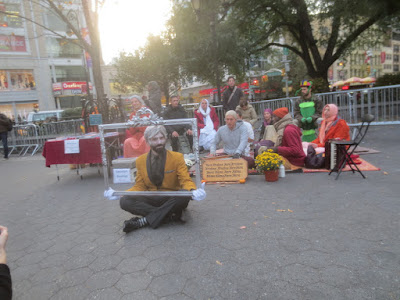(An Excerpt from the book Mysteries of the Ancient Vedic Empire, by Stephen Knapp)
As we look over the various cultures and religions of the world, we may ask if all religious systems are divine. Though they seem to conflict with each other on various points, still there are many areas of truth in which they all agree. Or you could say that some of the same essential truths can be found within each of them. And by a careful comparison, we can trace the essence of that truth back to what was originally explained in the Vedas, the oldest of all written texts, and, more importantly, what was the most developed of all cultures and philosophies.
In this way, we can also trace these essential truths back from one religion to another, and how the Vedic culture influenced Zoroastrianism, which influenced Judaism, which influenced Christianity, which influenced Islam. However, each succeeding religion became more distant from the original spiritual teachings and understanding, until each one thought that, rather than offering truths and processes to be followed, they promoted the idea that they were also the only way, superior to all else. When, actually, they were becoming increasingly narrow in their views, and less able to give people true enlightenment by showing how to uplift their consciousness to perceive the spiritual dimension, but demanding merely blind faith to follow it or go to hell, or some other such thing. This strategy hardly offers any real improvement or social upliftment, other than offering what may be a few moral principles, but little of any genuine spiritual development. And this is the loss, and what becomes a complete misdirection of the actual purpose of a spiritual path.
One of the early religions that others are traced back to is Zoroastrianism. But even this can be traced further back to the Vedic culture and the Rig Veda. To help explain some of this, we will reference Suhotra Swami’s book Dimensions of Good and Evil, where he describes what he calls the “Zoroastrian Nexus.”
It starts with a person named Jarutha described in the Rig Veda in less than complimentary terms, wherein he is against the sage Vasistha. It is also said (RV 7.9.6) that Vasistha had later killed Jarutha, possibly with Agni, fire. In the Rig Veda (7.13.1) Agni is also called the demon (asura) slayer.
In the Vedic texts, Jarutha is also called Jarasabdha. The Bhavishya Purana (Chapters 139-140) describes the history of the Maga Jarasabdha. The word maga refers to a dynasty of priests whom Jarasabdha was a progenitor, born in the family line of vira aditya, the powerful Aditya, meaning the sun god. So worship of the sun was important in their line.
Mandala Seven of the Rig Veda talks about Vasistha’s devotion to Varuna. Varuna was a great god of the rivers and seas, and was also called Asura-maya in the Rig Veda. Asura-maya means lord of the demons, the non-Vedics, because Varuna had power over the demonic undersea creatures. (Asura comes from the Sanskrit asun-rati, meaning he who gives life or rejuvenates, and maya because he measured out the sky. The word asura later became connected with those who were against the Vedic standards.)
Vasistha was fathered by the demigods Varuna and Mitra. It seems that both Jarutha and Vasistha were priests of Varuna, but a rivalry broke out between the two. Because of this rivalry, Jarutha left the Vedic culture and preached something different. He did not accept the Vedic standards and began to promote a different view, which was not accepted by Varuna. Due to this disagreement, Varuna cursed Jarutha and rejected him from Brahminical culture. So Jarutha was expelled from the region of Bharatvarsha, and he went to Persia. There he was able to propagate his own religion and philosophy.
In the region of Persia, Jarutha became known as Zarathustra, and began what became known as Zoroastrianism, called after his other name Zoroaster, which is a Greek derivative from the name Zarathustra. But even historically it is known that his early teachings aroused great hostility towards him.
In ancient Iran, the hereditary priestly caste was called the Magi. So it appears that the lineage of Maga Jarasabdha (Jarutha, Zarathustra) began from Varuna, the chief of the solar deities. In the Zoroastrian Zend Avesta, the name of God is Ahura-mazda, which matches Varuna’s Vedic title of Asura-maya. So, Zarathustra changed what had been the Vedic view into a different philosophy. Ahura Mazda, which means Wise Lord, became the name of the Zoroastrian God.
Furthermore, the Vedic demigods are headed by Brihaspati, whose other name is Angirasa, from where we get the name of Angra Mainyu in Zoroastrianism, who is depicted as the devil or Satan. So the Satan of Zoroastrianism is the Vedic spiritual master of the demigods.
In this way, Jarutha took the side of the demons and, though accepting Varuna as the main god, he promoted the idea that the non-Vedics were superior in their position. Basically, his philosophy was a rejection of the Vedic view, and he refashioned it in his own way. So there were still many Vedic aspects that remained. Even the language in the Zend Avesta is very similar to Sanskrit, and contains much pre-Zoroastrian material that can be related to the Rig Veda.
Nonetheless, Jarutha/Zarathustra called the demons Ahuras, or the pious ones, opposite of the Vedic view of them being called asuras, the demons. He also called them the daivas, similar to the Sanskrit name devas for demigods. In this way, the whole philosophy of Zoroastrianism was to take the Vedic philosophy and turn it upside down. So in Zoroastrianism the power of darkness became the power of light because he agreed with the non-Vedic point of view.
The point is that now we had Angra Mainyu as the name of the devil and Ahura Mazda as the name of God in this new faith. This idea of a God and a counterpart known as the devil, who could threaten the plans of God and divert the good intentions of the pious, now appeared for the first time, and is what filtered down through other religions of that region, including Judaism, Christianity and then Islam. The basis of this whole idea was pure concoction. And this idea and lack of higher spiritual knowledge is what has negatively affected any of the philosophies that followed this premise. This was because Zoroaster had accepted one demigod in contrast to another, rather than accepting the purer form of Lord Vishnu or Krishna as the Supreme, who has no rival. However, even in the Vedic system there may be evil spirits, subtle beings who are misguided and malevolent, and who cause trouble, but they are not beings who can threaten the will of the Supreme Lord.
As Suhotra Swami explains further: “It is curious how Zoroastrianism amplified this dualism [of a devil against God]. In the Vedic version, Asura-maya, Varuna, lord of the waters, dwells in the depths of the cosmic Garbhodaka Ocean, far below the earth. Yama’s [Yamaraja, the lord of death] underworld heaven and hell are very near that ocean; in the matter of chastising the sinful, Yama and Varuna are closely allied. In the Zoroastrian version, Ahura-mazda (Varuna) is the lord of light who gave his servant Yima an underworld kingdom called Vara, a realm that, while dark to human eyes, is mystically illuminated. In the Vedic version, Mitra and Varuna are a pair of demigods who in ancient times served the Supreme Lord as a team by supervising the realms of light and darkness. In the Zoroastrian version, Varuna is the supreme lord. Mitra is his light. The mantle of darkness (evil) is worn by an unceasing enemy of Ahura-mazda named Angra Mainyu or Ahriman. It appears that Angra Mainyu is the Vedic Angirasa (Brihaspati), spiritual master of the devas and a great foe of Shukracharya, the spiritual master of the asuras. From Mahabharata 1.66.54-55 we learn that Varuna took the daughter of Shukracharya, named Varuni, as his first wife.
“In the Vedic version, the powers of light and darkness or good and evil are not ultimate. By taking them to be ultimate, and moreover by reversing them (portraying the asuras as good and the devas as evil), Zarathustra twisted the Supreme Lord’s purpose for the cosmos that is administered on His behalf by such agents as Varuna, Yama and Brihaspati. Zoroastrianism was a revolutionary departure from Vedic philosophy.” (Suhotra Swami, Dimensions of Good and Evil, pp. 120-121)
Professor Norman Cohn, who heads an influential school of thought among religious historians, feels that the teachings of Zarathustra are the source of the philosophy of the apocalypse, the end of times–the belief in a final war between God’s army of angels and the devil’s army of demons. It is this idea that has continued down through various religions today.
In Zoroastrianism, this apocalyptic war was expected to start with the appearance of a messiah or savior, named Saoshyant, who would prevail against the forces of evil, at which time the dead would be resurrected from their graves. Then there would be a great assembly which would be a final judgment of all souls, the wicked ones would be destroyed and the righteous would become immortal, and the kingdom of God would be established on earth, wherein the righteous would enjoy life forever. It was the first time this sort of idea was promoted.
This has paved the way for many believers who are waiting for the end of times, the end of days, and they see signs of its approach in every evil thing that happens around them, expecting that they will be delivered to eternity in a resurrected but purified material body on a new earth. All of this shows a lack of deeper spiritual understanding, which has also paved the way for what can be seen as a sense of religious superiority, the feeling that my religion is better than yours and is the only way to salvation in the eyes of God. And from this has spread humongous quarrels, torture, hatred, and war, from nothing more than what has been traced back to a product of someone’s imagination simply because he rejected the Vedic system.
This borrowing from one religion to another can be recognized in many other ways as well. So let us look at a few more. For example, the idea that Adam and Eve were placed in the Garden of Eden that we find in the Bible, and where they are tempted to eat of the forbidden fruit by Satan, is almost entirely taken from the Jewish scriptures. Also the description of angels, such as Gabriel, Michael, Azrael, and Israfil, who have particular positions and purposes as we find in the Jewish tradition, which took these from the Persians, was also borrowed by Mohammed, who was said to have been given what became the Islamic teachings from the angel Gabriel.
Another example is the bridge to heaven. This is called Al Sirat by Mohammed. This is said to go over the abyss of hell, and is said to be finer than a hair, and sharper than the edge of a sword. Being led by Mohammed, Muslims are supposed to easily cross over it, whereas the wicked will lose their footing and fall into hell beneath them. However, the Jews had previously spoken of the bridge of hell, which is also no wider than a thread. But going further back, both the Muslims and the Jews are equally indebted to the Zoroastrians who had taught that on the last day, all men will be forced to pass over such a bridge, in their language called Pul Chinavad. 1
Even the concept of heaven and hell can be traced back to Zoroastrianism. Of course, there were also descriptions of both the heavenly and hellish planets in the Puranic texts. This was adopted by Zarathushtra and explained in the Gathas that heaven, or Garo-de-mana (Garotman in Persian), is where the angels sing hymns to God. This is described in the Yas xxxviii, 10; xxxiv, 2, which agrees with a similar description in Isaiah VI and Revelation of St. John.
Another example is the idea of paradise. In the Islamic faith, after crossing the Al Sirat, the faithful will reach paradise, which is situated in the seventh heaven. In this paradise, there are beautiful gardens, furnished with springs, fountains, and rivers, along with milk, honey, and trees with trunks of gold which produce the most delicious fruits. And more attractive than that are the 70 or so ravishingly beautiful girls called hur-ul-ayun on account of their big black eyes. However, most of this description is indebted to the Jews, for which, unfortunately, many of the Muslims have a great dislike. In the Jewish texts, such as Gemar Tanith, f. 25; Biracoth, f.34; Nidrash Sabboth, f. 37, all relate the future mansion of heaven as being a delicious garden in the seventh heaven. And the Midrash, Yalkut Shewini also describes it as having three gates with four rivers flowing with milk, wine, balsam, and honey. Anyone can see the similarities, one religion inheriting or borrowing from the other.
However, the Zoroastrians also described paradise in a similar manner. Paradise was called Bihisht and Minum which indicates crystal, where the righteous will enjoy all manner of delights, especially the company of huran-i-Bihisht or black-eyed nymphs of paradise, the care of whom is under the angel Zamiyad. So this seems to be the roots of the nymphs of paradise that was borrowed by later religions. Also, in one of the later writings of the Parsis (a group of Zoroastrians), the Nama Mihabad (40 & 41) describes that the lowest order of heaven is where the residents will enjoy all the delights of this world; nymphs, male and female slaves, meat and drink, clothing and bedding, articles of furniture, and other things too many to describe. 2 Of course, this sounds like hardly anything spiritual, but merely a continuation of the comforts any materialist would dream of having. Surely an enticing picture for those who think they deserve it.
Even Satan or the principle of evil is often described as a serpent, first in the Zend Avesta in Zoroastrianism, which in turn gave this to Christianity, and then on to Islam. Thus, all these often depict the evil principle as a serpent. 3 The German philosopher Schopenhaur also recognized this, as he stated in his book Religion and Other Essays (p.III): “And this confirms the views which has been established on other grounds that Jehova is a transformation of Ormuzd [Ahura Mazda], and Satan of the Ahriman [Angra Mainyu] who must be taken in connection that Ormuzd himself is a transformation of Indra [the Vedic demigod of heaven].”
We must consider, in this example, that in the Vedic philosophy, heaven is still a part of the temporary material creation and is not a part of the spiritual world. Therefore, Indra is a demigod and not the Supreme Being of the spiritual domain, which is beyond and outside the material worlds.
Another idea was the resurrection of the body, which actually is not found in the Vedic principles, but started with the Zoroastrian doctrine. The whole idea that during the last judgment the body would be resurrected was then accepted by the Jews, who lent it further to the Christians, especially through the teachings of Paul who was previously a Jew anyway, and then it went to Islam. The seed of this idea can be found in the Zend Avesta where it states (Zamyad Yasht XIX, 89-90): “This splendour attaches itself to the hero (who is to rise out of the number) of prophets (called Saoshyant) and to his companions, in order to make life everlasting, undecaying, imperishable, imputriscible, incorruptible, for ever existing, for ever vigorous, full of power, (at the time) when the dead shall rise again, and imperishableness of life shall commence, making life lasting by itself (without further support). All the world will remain for eternity in a state of righteousness; the devil will disappear from all those places whence he used to attack the righteous man in order to kill (him), and all his brood and creatures will be doomed to destruction.”
Herein we can see the Vedic premise of the eternal nature of the soul within the body, which will continue after the death of the body, but it has been misinterpreted to be the idea that the body is what will rise again. That it will live without the influence of the illusory nature, which here is suggested as the freedom from the presence of the devil, the principle of evil or illusion. And once free in this way, the living being can reach his full potential, such as described here as being indestructible, vigorous, everlasting, etc. This is all but a misinterpretation of the Vedic spiritual concepts, but filtered through the idea that the body is still the permanent identity of the eternal soul. We could discuss this for a lengthy time, which I have already done in some of my other books, but here we will leave it at this.
Even the Islamic phrase from the Koran “La-Elah-illiullah” (there is no God but God) is nothing but a repeat of the Zoroastrian formula “Nest ezad Magar Yazdan.”
Also, as every chapter of the Koran (except the ninth) opens with the words “Bismillah uar Rahman er Rahim,” this merely corresponds to the same formula which begins the Zoroastrian books, namely “Banam Yazdan Bakhshish gar dadar,” both basically meaning “in the name of the most merciful God.” So one is not so unique from the other, though they do not realize this.
As the Vedic followers called themselves Aryas or Aryans, the Parsis also called themselves Aryas, as described in the Zend Avesta, in such places as, “To the glory of the Aryas,” (Sirozah I, 9); “We sacrifice unto the glory of the Aryas made by Mazda,” (Sirozah II, 9); “How shall the country of the Aryas grow fertile,” (VIII, Yast, 9); “Ahura Mazda said, If men sacrifice unto Vretreghna made by Ahura… never will a hostile horde enter the Aryan countries, nor any plague, nor leprosy, nor venomous plants, nor the chariot of a foe, nor the uplifted spear of a foe.” (Bahram Yast, 48)
The question should be: Is it not about time for the Muslims to realize how much of their doctrines, ideas and sayings were inherited from previous cultures and religions, like Judaism and also Zoroastrianism? It can hardly be called a new revelation or special message from God. Each religion professes that their God is merciful, kind and loving. Or that their prophet or savior is giving something new. But as we find by studying the Koran and the Old Testament of the Bible, the revengeful nature of the God of the Torah is very much the same as the threatening nature of Allah in the Koran, where there are certain passages that tell the followers to make war upon and slay the infidels. These are both far different than the love for your neighbor that was recommended by Jesus in the New Testament. 4
As explained by Ganga Prasad in his book The Fountain-Head of Religion: “As for Zoroastrianism, its theism is in no way inferior to that of either Judaism or Mohammedanism. ‘Ahurmazda’ says the Rev. L. H. Mills, ‘is one of the purest conceptions which had yet been produced, and–we might add–is undoubtedly the prototype of the God of the Koran as well as the God of the Bible… But however superior to the belief of his contemporaries, the theism of the Koran can hardly be said to be superior to that of Judaism. The claim of the Koran, therefore, to be an independent revelation of God, on the plea of teaching a better theism than Judaism and Zorastrianism, to which it can be traced, is untenable.’” 5 Plus, the conception of Ahura-mazda was but a carry-over from the basics of the Vedic understanding of God.
There are also many similarities between the parables of Buddhism and Christianity, and between the lives of Buddha and Christ. Both are said to have been miraculously born, at which time they were surrounded by great omens, with a star presiding over each, in which case for Buddha was the Pushya Nakshatra. Both were visited by wise men upon their birth, such as when the rishi Asita came to King Suddhodana to see the newborn Buddha, and wise men came to Jerusalem to worship Jesus, as explained in the book of Matthew. And as the evil spirit of Mara came to tempt Gautama before he became the Buddha, Satan also tempted Jesus. Furthermore, many of the teachings of Jesus in the area of compassion, mercy, kindness, and inward development were also the same as or similar to those of Buddha. We could go on with many more of these kinds of similarities, others of which I have described in my book Proof of Vedic Culture’s Global Existence.
Furthermore, just as in the Vedic traditions there was the spiritual river of the Ganges (considered to be descending from the spiritual Karana Ocean) or the Yamuna (considered spiritually purified because Lord Krishna played in it), and wherein devotees would take a dip to be spiritually purified, the Hebrews also accepted the Jordan River whose waters were used for the same purpose, especially for baptizing to be free from one’s past sins.
In regard to the similarities between Sanskrit and the language of the Zend Avesta, even Max Muller recognized this very clearly. He went on to explain in his Chips From a German Workshop (Volume I, pp. 82-3): “It is clear from his (Eugene Burnouf’s) works and from Bopp’s valuable remarks in his ‘Comparative Grammar’ that Zend in its Grammar and Dictionary is nearer to Sanskrit than any other Indo-European language; many Zend words can be retranslated into Sanskrit simply by changing the Zend letters into their corresponding forms in Sanskrit… It differs from Sanskrit principally in its sibilants, nasals and aspirates. The Sanskrit s, for instance, is represented by the Zend h… Where Sanskrit differs in words or grammatical peculiarities from the northern members of the Aryan family, it frequently coincides with Zend. The numerals are the same up to 100. The name thousand, however, sahasra, is peculiar to Sanskrit and does not occur in any of the Indo-European dialects except in Zend, where it becomes hazanra.” 6
Even the biblical rendition of the universal creation, as described in Genesis, was adopted from that given in the Parsi scriptures, which is but a summary of that given in the Vedic literature, which is practically the most elaborate version of the process of the universal creation found anywhere in any religious text.
One last example of similarities that we will look at is the premise for the next appearance of a savior, or a second coming, after which everyone will rise again to live in a world of peace and God consciousness, without evil, or when their tribe will triumph over their enemies. This gives any believer a great deal of faith and hope in the future that they will be saved or delivered, if they continue to follow that particular religion. However, the idea that God or His prophet will appear again is not new, but was first related in regard to the avataras of God in the Vedic tradition.
As Lord Krishna explains in Bhagavad-gita (4.7): “Whenever and wherever there is a decline in religious practice, O descendant of Bharata, and a predominant rise of irreligion–at that time I descend Myself.”
However, unlike other religions, Lord Krishna descends in regularly scheduled appearances for specific purposes. It is not that He will descend one last time and that is the end. That is incomplete information. But He will continue to appear in the material creation as the need arises, throughout the various time periods known as yugas. These avataras are fully described in the Puranas so we can understand when and how often They will appear. Therein we see that God regularly descends into the material worlds in His different forms at different times to give society the spiritual knowledge they need to know in order to attain the purpose of life.
The Vedic texts also describe the next appearance of God in the future, this time as Lord Kalki when He will appear at the end of Kali-yuga to bring in the next golden age known as Satya-yuga. Therein He will kill all the miscreant kings and rulers and relieve the world of this burden and bring back a time of peace, harmony, cooperation, and God-consciousness. And this schedule of avataras continues through Satya-yuga, Treta-yuga, Dvapara-yuga, and again into Kali-yuga, all of which continue to repeat as many as 1000 cycles, called a kalpa or day of Brahma. In any case, this is the basis of any religion’s idea for the next coming of God.
All of these various similarities would show that many of the world’s religions and their legends and traditions, and even their precepts are to a great extent derived from Vedic culture. They may not be directly the same, but it is easy to see upon careful study that Christianity owes much to Vedic Dharma. Or as Max Muller said in his book Chips From a German Workshop (Volume I, Introduction, p.11), “There has been no entirely new religion since the beginning of the world. If we once understand this clearly, the words of St. Augustine, which have seemed startling to many of his admirers, become perfectly clear and intelligible, when he says, ‘what is now called the Christian religion has existed among the ancients and was not absent from the beginning of the human race until Christ came in the flesh, from which time the true religion, which existed already, began to be called Christian.’” 7
In this way, we can understand that the earliest of spiritual knowledge, which can be accepted as that found in the most elaborate Vedic texts, has but filtered down through generations, and that each successive religion did little but adopt in its own way or interpretation of what was already there, and that the essential spiritual truths found in all religions are but inheritances of the more elaborate teachings found in the Vedic texts and traditions. Thus, Vedic Sanatana-Dharma is like the roots and trunk of the tree of the various religions, which are like the branches of the tree. Just as rivers ultimately meet at the sea with a common goal, in spite of coming from different areas and conditions, as if coming to their ultimate unity, similarly Vedic Dharma is like the parent authority and root of all other religions.
Unfortunately, the Parsi, Jewish, Christian, and Muslim religions do not discuss in depth such things as the law of karma and reincarnation, even though these are mentioned in places or hinted at, but hardly described or analyzed very deeply. They do not discuss the nature or size of the soul, the soul’s transcendence beyond the body, nor do they mention the idea of a Supersoul. Nor do they describe much about the nature of God, His characteristics, personality, how He looks, or His numerous pastimes, except in only the briefest of ways. It seems, therefore, that the higher spiritual knowledge actually becomes reduced in succeeding religions as the information is passed down over the following generations of religious traditions. In Judaism, Christianity and then Islam, the true depth of spiritual knowledge was increasingly forgotten. Even the detailed descriptions of God and His real loving nature, as found in the Vedic literature, has similarly deteriorated in passing from the Vedas and Puranas into the Zend Avesta, the Old Testament, Bible, and further down the line. Therefore, to get back to the heart of the matter, we must get back to the roots, where it all began, with the Vedic tradition.
The evidence provided in this chapter concludes that at a very remote time, long before the dawn of history, the forefathers of all Aryan nations, such as India, Persia, Afghanistan, and even most if not all of Europe, lived under the banner of one common religion. Their common name was Arya, which they gave to Aryavarta (ancient India, the land of the Aryans), as well as to Iran (Persia), and other countries. In this way, Sanskrit was the mother of all Aryan languages, just as the Vedic religion is the parent of all religions which prevailed in all branches of the Aryan family, and we can recognize the remnants of this in many parts of the world today, if only we are educated in understanding what is the real Vedic Aryan culture.
It is this Vedic culture that gave humanity the deepest level of spirituality that has descended and circulated around the world in the various ways and into the religions that followed. The previous chapters of this book should have clearly illustrated this point.
Furthermore, there are three distinctions between any of the bone fide religions today, and that is: 1) The area in the world in which the religion was taught, 2) the time in history in which it appeared, and 3) the capacity of the people to understand it. In this way, only so much spiritual knowledge could be given if the people of the area were not able to comprehend deep spiritual knowledge. Saint Tukaram also saw these distinctions when he said, “the teaching is as per the capacity of the taught.” Because of this, in some cases the knowledge is given in a straightforward manner, such as we see in the Vedic literature in which so many questions are asked, and so many deep answers are provided, with the means by which the student can actually realize and perceive the spiritual truths that are described. In other religions we see the use of parables and stories, in which the followers can only understand the preliminary principles, which often go no farther than establishing the moral ethics by which to live. They often do not hold much in the way of higher spiritual principles. This means that to understand deeper spiritual truths, the person must go elsewhere.
This is like the difference between an abridged dictionary and an unabridged dictionary. They both hold the same knowledge, but one is more complete than the other. The unabridged dictionary will contain hundreds or thousands more words than the abridged dictionary. This is the same difference between the religions. The Vedic texts will contain much more spiritual knowledge and information on understanding God or the Absolute Truth. So the more complete religion or spiritual path will give you the deeper means of understanding who you are and your relationship with God and all other beings. It will also provide you the process by which you can spiritualize your consciousness to the degree in which you can begin to directly perceive this higher reality. It is much more mature and developed, over and above those that are simplified and elementary. A most developed religion will also facilitate one’s becoming free from attachment, selfishness, violence, malice and hatred, by which a person can more easily focus on the spiritual nature of oneself and God, and the unity we all share with each other in that light. Whereas a religion that is incomplete and allows followers to hold on to these negative characteristics, especially violence, hatred toward others, emphasis on our differences, etc., will keep one bound up to this earthly plane of duality, which is the exact opposite purpose of any genuine spiritual process.
Vedic Dharma, on the other hand, is defined as that which leads to glory, peace, prosperity, and elevates society to liberation from this earthly existence. It is the understanding that this world is not our real home, never was and never will be. But it is also the portal through which, by living the right way, can propel us into the spiritual dimension, far away from this temporary earthly existence. This is why Vedic Dharma is meant to help all of society, and not divide society into those who are “saved” and those who are not. It teaches society to discard hatred toward one another and attain mental peace and internal contentment. This is actually meant to be the fundamental principle of all religions, which then encourages right conduct for attaining realization of the Eternal Truth, the reality of who and what you really are, and your relation to the Supreme Lord.
However, the attainment of moksha or liberation from material existence is unique in Vedic culture because most religions proclaim the ideal of merely reaching heaven, which is still considered part of the material creation. Yes, moksha also means rising above material suffering, ignorance, and the attainment of the Eternal Truth and bliss, right here and right now, in this life. It is not necessarily something that only can be attained after death. Whereas the non-Vedic religions often put emphasis on moral conduct, social behavior, ethics, etc., for reaching heaven in the next life, mainly with the idea of continuing the enjoyment of material facilities, yet give little emphasis on deeper spiritual philosophy. So in such religions there remains many philosophical questions for which there are limited answers. But it is up to the individual to choose which process he or she wants to accept in reaching a natural level of spiritual realization. That is why no Vedic or Hindu sect has tried to propagate or increase their followers through the use of the sword or by force, or through fear of torture, intimidation, or other such means. There is no history that shows the use of brutality for the propagation of Vedic culture. It is spread only through the purity of its teachings and the means by which people can use it for their own enlightenment. It is that means alone which is meant to attract people to investigate and then follow this spiritual way of life. It is meant to be a natural process, not forced.
This is why Dharmists, Hindus or devotees do not interfere in the religion of others and expect the same respect in return. This is also why anyone of any religion can easily live amongst those who follow Vedic Dharma.
Vedic culture contains a philosophy that goes back to a time beyond history, and has developed over millenniums. Even Sanskrit is considered to have descended from the Shabda-brahman, or the spiritual vibration that exists outside of the material creation, beyond time and space. Furthermore, we find that the insights given by the great rishis and sages are coming from a spiritually realized level of consciousness that is beyond mere faith or cultivated knowledge. Such insights and revelations come from a level of direct spiritual perception and experience, with the means and directions given to others so we can follow them to attain our own realizations.
The completeness of the Vedic spiritual philosophy can be seen with but a small analysis. This does not mean there are not great amounts of wisdom in all religions, but where else are you going to go to understand the roots of the knowledge of karma, or reincarnation, or the science of the nature or size and location of the soul, or the understanding of the Paramatma or Supersoul, and the means to unite with the Supreme? Where else are you going to find such detailed descriptions about God, or our relationship with God, or so many instructions given by God, or the means to acquire a direct connection with God? What other religion has such clear descriptions about the spiritual realm and how to reach that level of existence? We need to recognize the unique nature of the Vedic tradition and its philosophy.
Furthermore, the Vedic spiritual path offers the view that every creature is sacred. Spiritually we are all of the same quality. As explained in the Sri Ishopanishad: ishavasyam idam sarvam, yat kincha jagatyam jagat, which means that everything in this creation, both animate and inanimate, is part of the Lord’s energy, and that God’s energy is within all beings. Therefore, every creature has a spiritual significance. Plus, through the Vedic system of spiritual development, everyone can access that spiritual perception. It is not a matter of faith, but a process of realization. The Vedic process begins with faith, as all spiritual paths do, but if the path is practiced properly, it is expected to bring you to the level of having your own spiritual realizations and perception. And to do this there are so many means of assistance, such as the instructions from the Vedic texts, guidance from the realized gurus, and the association of other sadhus or devotees, all meant to help inspire and propel you forward to higher and higher levels of spiritual perception, realization and experience.
However, in Western religions, it is often presented that a follower can only attain such access through the approval of or connection with the church or religious institution. Without that, then you are finished, sometimes to eternal damnation, depending on the religion. In this way, the religion creates an air of exclusiveness, that the only way you can understand anything spiritual or have a connection with God is by accepting that particular church or denomination, or their specific savior or prophet. And, of course, the only people that are privileged to being “saved” are those who follow that same religion. Quite honestly, this is a very shallow level of understanding, like showing your allegiance to your religion by disliking, demeaning or even hating all others.
The Vedic or Dharmic approach to spiritual development is the antithesis of this. There is no restriction to spiritual knowledge, and all questions can be asked. The avenues of spiritual discovery are the guru (spiritual teacher), shastra (spiritual texts) and sadhus (other devotees or sages). This leads to the freedom of choice in the ways of understanding and ultimately experiencing the Divine. This is the real goal of human life. Everyone is coming from different backgrounds, and everyone has different lessons to learn. So personal investigations to find spiritual truth should be allowed and provided for everyone. It should not be controlled or limited by any certain religious persuasion.
This should especially be the case when we realize the premise of this chapter, that the essence and heart of all spiritual knowledge is descending from Vedic culture, Sanatana-Dharma, and that to get to the deepest level of spiritual understanding would be to take a deeper look at what it has to offer all of humanity, socially and individualistically, not only for peace, compassion, cooperation, harmony, etc., but to attain a closer link with the Divine. Nothing else offers a higher level of happiness, completeness or fulfillment, which is ultimately for what everyone is searching. This is the purpose of life.
CHAPTER NOTES
1. Prasad, Ganga, The Fountain-Head of Religion: A Comparative Study of the Principal Religions of the World and a Manifestation of Their Common Origin From the Vedas, The Arya Pratinidhi Sabha, U.P., 1927, p.5.
2. Ibid., p.6.
3. Prasad, Ganga, The Fountain-Head of Religion: A Comparative Study of the Principal Religions of the World and a Manifestation of Their Common Origin From the Vedas, The Arya Pratinidhi Sabha, U.P., 1927, p.59.
4. Ibid., pp.11-13.
5. Ibid., p.13.
6. Muller, Max, Chips From a German Workshop, Volume I, pp. 82-3.
7. Prasad, Ganga, The Fountain-Head of Religion: A Comparative Study of the Principal Religions of the World and a Manifestation of Their Common Origin From the Vedas, The Arya Pratinidhi Sabha, U.P., 1927, p.26.






















































